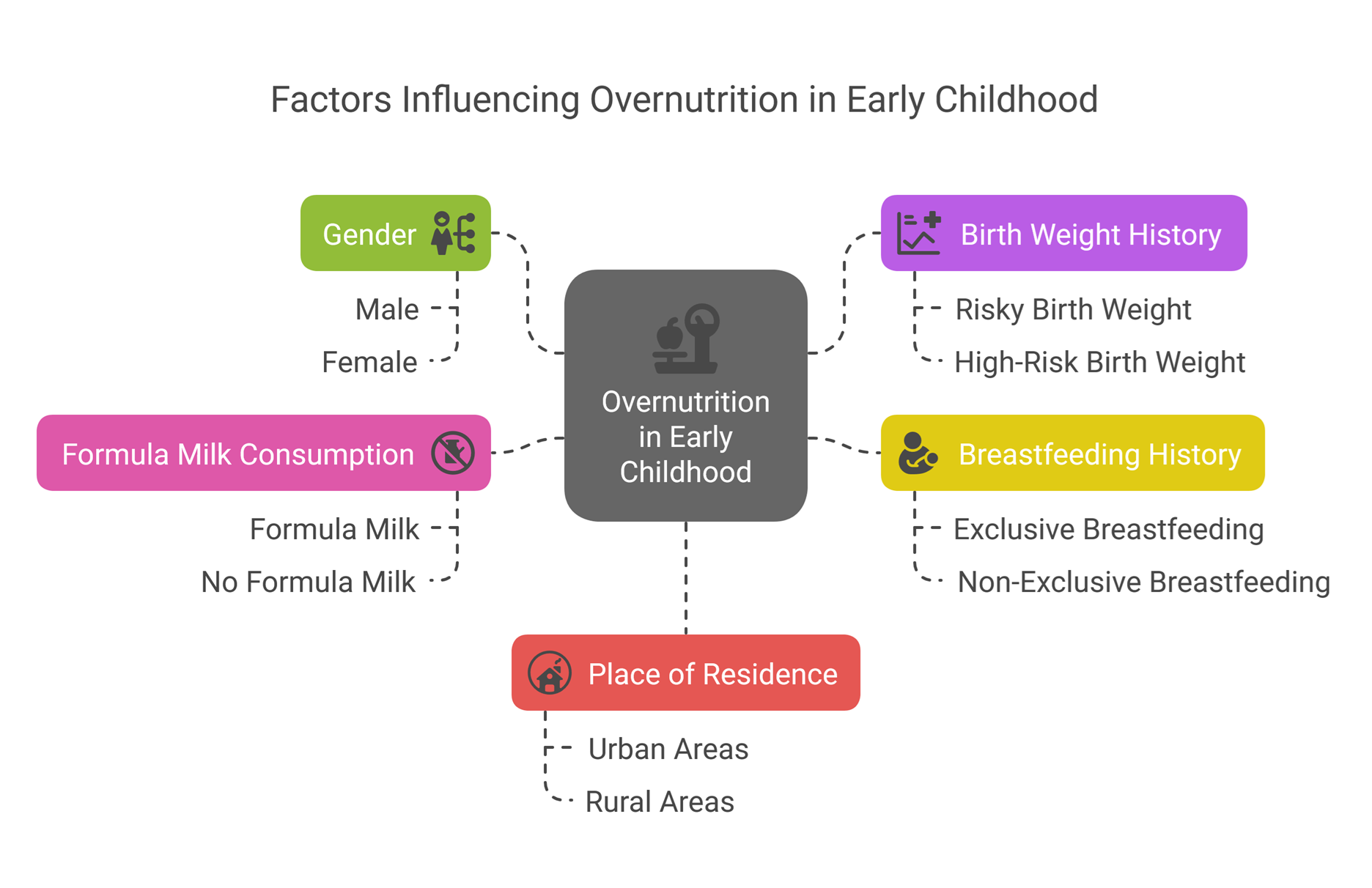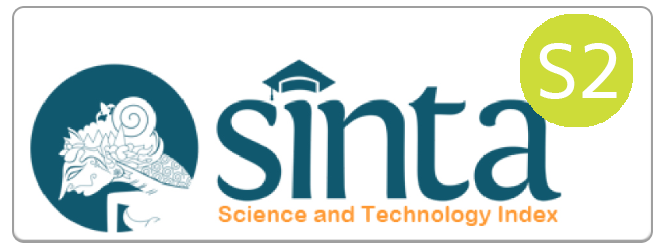Factors Related to Overnutrition in Early Childhood in Urban and Rural Areas of Bangka Belitung Islands Province (An Analysis Of 2023 SKI Data)
Keywords:
Overnutrition, Gender, Breastfeeding History, Birth weight history, Exclusive Breastfeeding, Formula milkAbstract
Early childhood is a critical period for the basic development of physical, social, and cognitive aspects. One of the nutritional problems that often occurs is overnutrition. This study aims to determine the factors of gender, history of birth weight, history of breastfeeding, and consumption of formula milk related to the incidence of overnutrition in early childhood in urban and rural areas. This study uses secondary data from the 2023 SKI data. The design of this study is a cross-sectional study, a population of children aged 0-24 months with a sample size of 417 children. Univariate data analysis, a Chi-square test to explore differences in place of residence in overnutrition status, and bivariate (logistic regression) with the help of Stata software version 17. The results show that 7.26% of early childhood children who experience overnutrition live in rural areas, and 6.83% live in urban areas. There was no significant association between male gender (OR=0.99, 95% CI=0.40–2.46), history of risky birth weight (OR=1.00, 95% CI=0.54–3.28), non-exclusive breastfeeding (OR=1.16, 95% CI=0.40–3.31), or consumption of formula milk (OR=1.32, 95% CI=0.46–3.79) in urban areas with overnutrition (p>0.05). There was no significant association between male gender (OR=0.99, 95% CI=0.25–3.90), history of high-risk birth weight (OR=1.00, 95% CI=0.99–1.00), non-exclusive breastfeeding (OR=0.77, 95% CI=0.15–3.92), or formula milk consumption (OR=0.84, 95% CI=0.16–4.31) in rural areas with overnutrition (p>0.05). These findings suggest that although gender, history of birth weight, history of breastfeeding, and consumption of formula milk were not significantly associated with overnutrition in early childhood, interventions should focus on structural determinants such as maternal education and access to exclusive breastfeeding support, especially in rural communities.
Downloads
References
Kemenkes RI. Standar Antropometri Anak Nomor 2 Tahun 2020. In: Peraturan Menteri Kesehatan Republik Indonesia. Jakarta: Kementerian Kesehatan RI; 2020. p. 1–78.
WHO. World Health Organization. 2022 [cited 2024 Sep 19]. Obesity and Overweight. Available from: https://www.who.int/news-room/fact-sheets/detail/obesity-and-overweight
Riskesdas. Badan Penelitian dan Pengembangan Kesehatan Kementerian RI Riset Kesehatan Dasar 2013. Jakarta: Kementerian Kesehatan Republik Indonesia Badan Penelitian dan Pengembangan Kesehatan; 2013.
Riskesdas. Badan Penelitian dan Pengembangan Kesehatan Kementerian RI tahun 2018. 2018;
Kemenkes RI. Hasil Studi Status Gizi Indonesia (SSGI) Tingkat Nasional Provinsi dan Kabupaten Kota Tahun 2021. Jakarta: Kementerian Kesehatan RI; 2021.
Kemenkes RI. Hasil Studi Status Gizi Indonesia (SSGI) Tingkat Nasional Provinsi dan Kabupaten Kota Tahun 2022. Kementerian Kesehatan RI. Jakarta; 2022. 1–7 p.
Kemenkes RI. Survei Kesehatan Indonesia. Vol. 01, Badan Kebijakan Pembangunan Kesehatan. Jakarta: Badan Kebijakan Pembangunan Kesehatan Kementerian Kesehatan RI; 2023. 1–68 p.
Malczyk Ż, Pasztak-Opiłka A, Zachurzok A. Different Eating Habits Are Observed in Overweight and Obese Children Than in Normal-Weight Peers. Children. 2024;11(7):834.
Simmonds M, Llewellyn A, Owen C, Woolacott N. Predicting Adult Obesity from Childhood Obesity a Systematic Review and Meta Analysis. 2016;17(2):95–107.
Indanah I, Sukesih S, Luthfin F, Khoiriyah K. Obesitas Pada Balita. Jurnal Ilmu Keperawatan dan Kebidanan. 2021;12(2):242.
Mauliza M, Arini N. Faktor yang Mempengaruhi Obesitas dan Penanganannya pada Anak. Jurnal Kedokteran dan Kesehatan Mahasiswa Malikussaleh. 2022;1(3):77.
Rachmawati R, Salimar S, Sudikno S, Irawan IR, Sari YD. Faktor Sosiodemografi yang Berhubungan dengan Overweight dan Obesitas Pada Balita di Indonesia Perbandingan Perdesaan dan Perkotaan. Penelitian Gizi dan Makanan (The Journal of Nutrition and Food Research). 2022;45(1):23–34.
Kemenkes RI. Pedoman Pegisian Kuesioner Survei Kesehatan Indonesia (SKI) 2023. Badan Kebijakan Pembangunan Kesehatan. Jakarta; 2023. 1–381 p.
Rahmadia RZ, Mardiyah S. Faktor yang Berhubungan dengan Kejadian Gizi Lebih pada Balita di Kelurahan Sungai Bambu. Jurnal Kesehatan Masyarakat. 2023;11(1):114–20.
Shi J, Guo Q, Fang H, Cheng X, Ju L, Wei X, et al. The Relationship between Birth Weight and the Risk of Overweight and Obesity among Chinese Children and Adolescents Aged 7–17 Years. Nutrients. 2024;16(715):1–12.
Yang Z, Dong B, Song Y, Wang X, Dong Y, Gao D, et al. Association between Birth Weight and Risk of Abdominal Obesity in Children and Adolescents a School Based Epidemiology Survey in China. BMC Public Health. 2020;20(1):1–9.
Saha J, Chouhan P, Ahmed F, Ghosh T, Mondal S, Shahid M, et al. Overweight Obesity Prevalence among Under Five Children National Family Health Survey (2015-2016). Nutrients. 2022;14(3621):1–18.
Tanveer M, Hohmann A, Roy N, Zeba A, Tanveer U, Siener M. The Current Prevalence of Underweight Overweight and Obesity Associated with Demographic Factors among Pakistan School Aged Children and Adolescents An Empirical Cross-Sectional Study. International Journal of Environmental Research and Public Health. 2022;19(18):1–15.
Nurwanti E, Hadi H, Chang JS, Paramashati BA, Gittelson J. Rural Urban Differences in Dietary Behavior and Obesity Result of the Riskesdas Study in 10-18 Year Old Indonesian Children and Adolescent. Nutrients [Internet]. 2019;11(2813):1–14. Available from: www.mdpi.com/journal/nutrients
Efrizal W. Dampak Ekologis Bangka Belitung Terhadap Keadaan Gizi dan Kesehatan. Jurnal Ilmu Gizi Indonesia. 2020;1(2):1–9.
Kemenkes RI. Laporan Tematik Survei Kesehatan Indonesia. Jakarta: Badan Kebijakan Pembangunan Kesehatan; 2024. 1–71 p.
Crouch E, Abshire DA, Wirth MD, Hung P, Benavidez GA. Rural Urban Differences in Overweight and Obesity Physical Activity, and Food Security Among Children and Adolescents. Preventing Chronic Disease. 2023;20:1–10.
Gan Q, Xu P, Yang T, Cao W, Xu J, Li L, et al. Sugar Sweetened Beverage Consumption Status and its Association with Childhood Obesity Among Chinese Children Aged 6–17 Years. Nutrients. 2021;13(7).
Oktaviani S, Mizutani M, Nishide R, Tanimura S. Factors Associated with Overweight Obesity of Children Aged 6–12 Years in Indonesia. BMC Pediatrics. 2023;23(1):1–11.
Firginia N, Ruhana A. Hubungan Asupan Energi , Zat Gizi Makro , dan Pengetahuan Gizi Ibu dengan Status Gizi Balita Usia 2-5 Tahun di Puskesmas Menur Surabaya. Jurnal Gizi Universitas Negeri Surabaya. 2024;4(2):664–70.
Hasyim DI, Saputri N. Hubungan Faktor Sosiodemografi dengan Status Gizi pada Anak Balita. Jurnal Riset Kebidanan Indonesia. 2022;6(1):18–23.
Sahoo K, Sahoo B, Choudhury A, Sofi N, Kumar R, Bhadoria A. Childhood Obesity Causes and Consequences. Journal of Family Medicine and Primary Care. 2015;4(2):187.
Wirakesuma TM., Desy D, Putri BO. Hubungan Aktivitas Fisik Pola Makan Jenis Kelamin Teman Sebaya dan Uang Saku dengan Kejadian Gizi Lebih Pada Anak di Sekolah Dasar Negeri 002 Sekupang Kota Batam. Jurnal Ilmu Kedokteran dan Kesehatan Indonesia. 2022;2(2):187–216.
Fikhriyyah A. Hubungan Makrosomia MP ASI Dini Aktivitas Fisik dan Pola Makan terhadap Kejadian Gizi Lebih Pada Anaka Usia 3-5 Tahun. 2023;VIII(I):1–19.
Zhang X, Liu J, Ni Y, Yi C, Fang Y, Ning Q, et al. Global Prevalence of Overweight and Obesity in Children and Adolescents: A Systematic Review and Meta-Analysis. JAMA Pediatrics. 2024;178(8):800–13.
Lubis MY, Hermawan D, Febriani U, Farich A. Hubungan Antara Faktor Keturunan Jenis Kelamin dan Tingkat Sosial Ekonomi Orang Tua dengan Kejadian Obesitas pada Mahasiswa di Universitas Malahayati. Jurnal Human Care. 2020;5(4):891–900.
Cooper AJ, Gupta SR, Moustafa AF, Chao AM. Sex Gender Differences in Obesity Prevalence Comorbidities and Treatment. Current Obesity Reports [Internet]. 2021;10(4):458–66. Available from: https://doi.org/10.1007/s13679-021-00453-x
Shah B, Tombeau Cost K, Fuller A, Birken CS, Anderson LN. Sex and Gender Differences in Childhood Obesity Contributing to the Research Agenda. BMJ Nutrition, Prevention and Health. 2020;3(2):387–90.
Xia Q, Cai H, Xiang YB, Zhou P, Li H, Yang G, et al. Prospective Cohort Studies of Birth Weight and Risk of Obesity Diabetes and Hypertension in Adulthood Among the Chinese Population. Journal of Diabetes. 2019;11(1):55–64.
Rito AI, Buoncristiano M, Spinelli A, Salanave B, Kunešová M, Hejgaard T, et al. Association Between Characteristics at Birth Breastfeeding and Obesity in 22 Countries. The WHO European Childhood Obesity Surveillance Initiative. Obesity Facts. 2019;12(2):226–43.
Supardi N, Rohana T, Hasanah NL, Fajriana H, Puspareni DLP, Maghfiro KAMN, et al. Buku Gizi pada Bayi dan Balita. Yayasan Kita Menulis; 2023.
Fajariyah SU, Ilham S, Triana D. Pemberian Asi Eksklusif dan Non Eksklusif dengan Kejadian Obesitas pada Anak Usia 24-35 Bulan di Bengkulu. Jurnal Kedokteran dan Kesehatan. 2022;18(1):88.
Jebeile H, Kelly SA, O’Malley G, Baur AL. Obesity in Children and Adolescents Epidemiology Causes Assessment and Management. 2022. p. 351–65.
Diallo R, Baguiya A, Balde MD, Camara S, Diallo A, Camara BS, et al. Prevalence and Factors Associated With Overweight in Children Under 5 Years in West African Countries. Journal of Public Health Research. 2023;12(3).
Mannan H. Early Infant Feeding of Formula or Solid Foods and Risk of Childhood Overweight or Obesity in a Socioeconomically Disadvantaged Region of Australia: A Longitudinal Cohort Analysis. International Journal of Environmental Research and Public Health. 2018;15(8).
Yopiana E, Dewi YLR, Murti B. Relationship Between Formula Milk and the Incidence Obesity in Children Under Five Meta-Analysis. Indonesian Journal of Medicine. 2020;5(4):299–307.
Palaska E, Antoniou E, Tzitiridou-Chatzopoulou M, Eskitzis P, Orovou E. Correlation between Breastfeeding Maternal Body Mass Index and Childhood Obesity. Epidemiologia. 2024;5(3):411–20.
UNICEF. Landscape Analysis Tool on Overweight and Obesity in Children and Adolescents. New York; 2022. 69 p.
Solikhah S, Setyowati S. Manfaat Pemberian ASI Eksklusif dalam Menstimulasi Reaksi Bayi Usia 4 Sampai 6 Bulan di Bee Creative Day Care Sambikerep. Ejournal Universitas Negeri. 2019;8(1):1–8.
Shah R, Sabir S, Alhawaj FA. National Library of Medicine. 2022 [cited 2024 Sep 19]. Fisiologi Air Susu Ibu. Available from: https://www.ncbi.nlm.nih.gov/books/NBK539790/
Hopkins D, Steer CD, Northstone K, Emmett PM. Effects on Childhood Body Habitus of Feeding Large Volumes of Cow or Formula Milk Compared with Breastfeeding in the Latter Part of Infancy. American Journal of Clinical Nutrition [Internet]. 2015;102(5):1096–103. Available from: https://doi.org/10.3945/ajcn.114.100529
Huang J, Zhang Z, Wu Y, Wang Y, Wang J, Zhou L, et al. Early Feeding of Larger Volumes of Formula Milk is Associated with Greater Body Weight or Overweight in Later Infancy. Nutrition Journal. 2018;17(1):1–9.

Published
How to Cite
Issue
Section
Copyright (c) 2025 Afifa Naura Harahap, Nur Hafidha Hikmayani, Sumardiyono Sumardiyono

This work is licensed under a Creative Commons Attribution-NonCommercial-ShareAlike 4.0 International License.
Most read articles by the same author(s)
- Sumardiyono Sumardiyono, Maria Paskanita Widjanarti, Farhana Syahrotun Nisa Suratna, Lusi Ismayenti, Seviana Rinawati, Tutug Bolet Atmojo, Warda Yussy Rha, Jordan Syah Gustav, Bekti Utomo, Reni Wijayanti, Bachtiar Chahyadhi, Risk Factors of Pulmonary Obstruction Among Textile Industry Workers , Journal of Health and Nutrition Research: Vol. 4 No. 2 (2025)
- Dien Abdul Munir, Nur Hafidha Hikmayani, Sumardiyono Sumardiyono, Puskesmas Accreditation Status And Asset Ownership Potentially Lowering Stunting : Multilevel Analysis In Jeneponto and Barru Districts, South Sulawesi , Journal of Health and Nutrition Research: Vol. 4 No. 2 (2025)
















